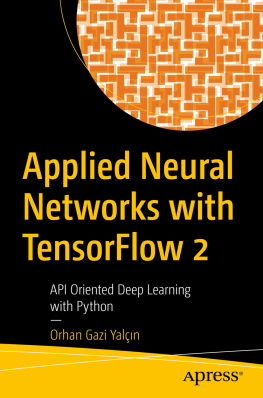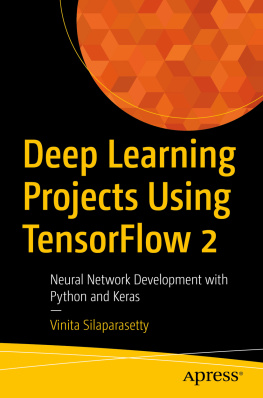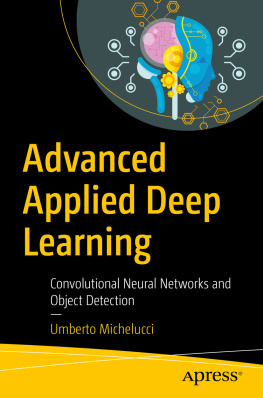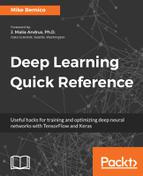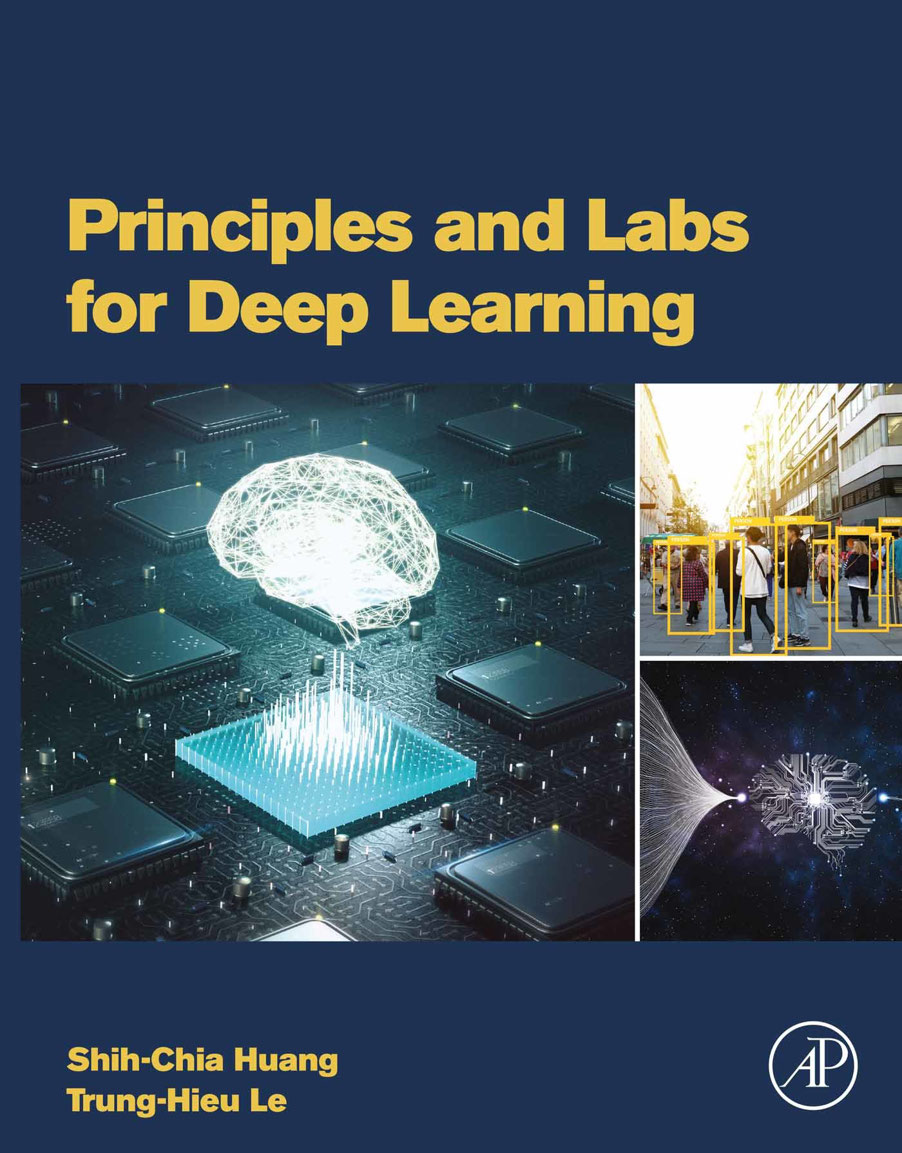Principles and Labs for Deep Learning
First Edition
Shih-Chia Huang
Professor, Department of Electronic Engineering, National Taipei University of Technology, Taipei, Taiwan
Trung-Hieu Le
Assistant Professor, Department of Electronic Engineering, National Taipei University of Technology, Taipei, Taiwan
Lecturer, Faculty of Information Technology, Hung Yen University of Technology and Education, Hung Yen, Vietnam

Table of Contents
Cover image
Title page
Copyright
Preface
Environment installation
Abstract
1: Python installation
2: TensorFlow installation
3: Python extension installation
4: Jupyter notebook
5: PyCharm IDE
6: GitHub labs
Chapter 1: Introduction to TensorFlow
Abstract
1.1: Deep learning
1.2: Introduction to TensorFlow
1.3: Improvement of TensorFlow
1.4: Eager execution
1.5: Keras
1.6: Tf.data
Chapter 2: Neural networks
Abstract
2.1: Introduction to neural networks
2.2: Introduction to Kaggle
2.3: Experiment 1: House price prediction
2.4: Introduction to TensorBoard
2.5: Experiment 2: Overfitting problem
Chapter 3: Binary classification problem
Abstract
3.1: Machine learning algorithms
3.2: Binary classification problem
3.3: Experiment: Pokmon combat prediction
Chapter 4: Multi-category classification problem
Abstract
4.1: Convolutional neural network
4.2: Multi-category classification
4.3: Experiment: CIFAR-10 image classification
Chapter 5: Training neural network
Abstract
5.1: Backpropagation
5.2: Weight initialization
5.3: Batch normalization
5.4: Experiment 1: Verification of three weight initialization methods
5.5: Experiment 2: Verification of batch normalization
5.6: Comparison of different neural networks
Chapter 6: Advanced TensorFlow
Abstract
6.1: Advanced TensorFlow
6.2: Using high-level keras API and custom API of TensorFlow
6.3: Experiment: implementation of two network models using high-level keras API and custom API
Chapter 7: Advanced TensorBoard
Abstract
7.1: Advanced TensorBoard
7.2: Experiment 1: Using tf.summary.image API to visualize training results
7.3: Experiment 2: Hyperparameter tuning with TensorBoard HParams
Chapter 8: Convolutional neural network architectures
Abstract
8.1: Popular convolutional neural network architectures
8.2: Experiment: Implementation of inception-v3 network
Chapter 9: Transfer learning
Abstract
9.1: Transfer learning
9.2: Experiment: Using Inception-v3 for transfer learning
Chapter 10: Variational auto-encoder
Abstract
10.1: Introduction to auto-encoder
10.2: Introduction to variational auto-encoder
10.3: Experiment: Implementation of variational auto-encoder model
Chapter 11: Generative adversarial network
Abstract
11.1: Generative adversarial network
11.2: Introduction to WGAN-GP
11.3: Experiment: Implementation of WGAN-GP
Chapter 12: Object detection
Abstract
12.1: Computer vision
12.2: Introduction to object detection
12.3: Object detection methods
12.4: Experiment: Implementation of YOLO-v3
Index
Copyright
Academic Press is an imprint of Elsevier
London Wall, London EC2Y 5AS, United Kingdom
B Street, Suite 1650, San Diego, CA 92101, United States
Hampshire Street, 5th Floor, Cambridge, MA 02139, United States
The Boulevard, Langford Lane, Kidlington, Oxford OX5 1GB, United Kingdom
Copyright 2021 Elsevier Inc. All rights reserved.
No part of this publication may be reproduced or transmitted in any form or by any means, electronic or mechanical, including photocopying, recording, or any information storage and retrieval system, without permission in writing from the publisher. Details on how to seek permission, further information about the Publishers permissions policies and our arrangements with organizations such as the Copyright Clearance Center and the Copyright Licensing Agency, can be found at our website:
This book and the individual contributions contained in it are protected under copyright by the Publisher (other than as may be noted herein).
Notices
Knowledge and best practice in this field are constantly changing. As new research and experience broaden our understanding, changes in research methods, professional practices, or medical treatment may become necessary.
Practitioners and researchers must always rely on their own experience and knowledge in evaluating and using any information, methods, compounds, or experiments described herein. In using such information or methods they should be mindful of their own safety and the safety of others, including parties for whom they have a professional responsibility.
To the fullest extent of the law, neither the Publisher nor the authors, contributors, or editors, assume any liability for any injury and/or damage to persons or property as a matter of products liability, negligence or otherwise, or from any use or operation of any methods, products, instructions, or ideas contained in the material herein.
Library of Congress Cataloging-in-Publication Data
A catalog record for this book is available from the Library of Congress
British Library Cataloguing-in-Publication Data
A catalogue record for this book is available from the British Library
ISBN 978-0-323-90198-7
For information on all Academic Press publications visit our website at https://www.elsevier.com/books-and-journals

Publisher: Mara Conner
Acquisitions Editor: Chris Katsaropoulos
Editorial Project Manager: Isabella C. Silva
Production Project Manager: Swapna Srinivasan
Cover Designer: Greg Harris
Typeset by SPi Global, India
Preface
Shih-Chia Huang; Trung-Hieu Le, Department of Electronic Engineering, National Taipei University of Technology, Taipei, Taiwan
In 1943, Warren McCulloch and Walter Pitts introduced a computational model based on a threshold logic algorithm, paving the way for the development of artificial intelligence (AI). The field of AI research was founded at the Dartmouth summer research project on artificial intelligence in 1956. In the nearly 80 years of development history, AI has experienced many ups and downs, especially the two AI winters, which are known as the periods of reduced funding and interest in AI research. After AlphaGo, a deep learning-based computer Go program developed by Google DeepMind, defeated a professional Go player in 2015, AI has once again attracted considerable research attention. In recent years, AI with deep learning algorithms has been dramatically improved and successfully applied to many problems in academia and industry. Recognizing the potential and power of deep learning, many world-class technology companies, such as Google, Facebook, Microsoft, Tesla, and others, have invested a lot of manpower and resources in researching and developing their products using deep learning.


